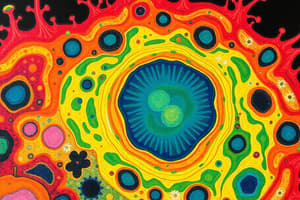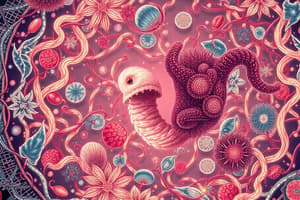Podcast
Questions and Answers
What is a primary function of carbohydrates in living organisms?
What is a primary function of carbohydrates in living organisms?
- Insulating cellular structures
- Genetic information transmission
- Energy storage and structural support (correct)
- Catalyzing biochemical reactions
Which statement accurately describes prokaryotic cells?
Which statement accurately describes prokaryotic cells?
- They are larger and more complex than eukaryotic cells.
- They are primarily involved in genetic instruction transmission.
- They lack a nucleus and are simpler in structure. (correct)
- They possess a nucleus and multiple membrane-bound organelles.
What role do genetic mutations play in organisms?
What role do genetic mutations play in organisms?
- They ensure the stability of the genetic code.
- They only affect non-heritable traits.
- They are always beneficial for the species.
- They can lead to significant changes in an organism's traits. (correct)
How does natural selection contribute to evolution?
How does natural selection contribute to evolution?
What is the fundamental unit of life?
What is the fundamental unit of life?
What does biodiversity encompass?
What does biodiversity encompass?
Which branch of biology would primarily focus on understanding the interactions of living organisms in their environments?
Which branch of biology would primarily focus on understanding the interactions of living organisms in their environments?
What is the primary purpose of photosynthesis?
What is the primary purpose of photosynthesis?
Which of the following best describes metabolism?
Which of the following best describes metabolism?
Which of the following is considered an abiotic component of an ecosystem?
Which of the following is considered an abiotic component of an ecosystem?
Flashcards
What is Biology?
What is Biology?
Biology is the scientific study of life, encompassing all living things, their structure, function, origin, evolution, and distribution.
Cell Types
Cell Types
Two main types of cells: prokaryotic (simpler, no nucleus) and eukaryotic (complex, with a nucleus and organelles).
Biological Molecules
Biological Molecules
Four main types crucial for life: carbohydrates (energy), lipids (storage), proteins (functions), and nucleic acids (genetic material).
Evolution's mechanism
Evolution's mechanism
Signup and view all the flashcards
Genetics' role
Genetics' role
Signup and view all the flashcards
Ecosystem Components
Ecosystem Components
Signup and view all the flashcards
Ecological Concepts
Ecological Concepts
Signup and view all the flashcards
Biodiversity
Biodiversity
Signup and view all the flashcards
Organismal Biology
Organismal Biology
Signup and view all the flashcards
Metabolism
Metabolism
Signup and view all the flashcards
Study Notes
Introduction to Biology
- Biology is the scientific study of life, encompassing all living organisms.
- Key areas of study include: cell biology, genetics, evolution, ecology, and organismal biology.
- Biology seeks to understand the structure, function, growth, origin, evolution, and distribution of living organisms.
- Biological processes and systems involve diverse interactions among various levels of organization, from molecules to ecosystems.
The Cell: Fundamental Unit of Life
- All living organisms are composed of cells, which are the smallest structural and functional units of life.
- There are two main types of cells: prokaryotic and eukaryotic.
- Prokaryotic cells are simpler, smaller, and lack a nucleus.
- Eukaryotic cells are more complex, larger, and contain a nucleus and other membrane-bound organelles.
- Key components of cells include: cell membrane, cytoplasm, DNA (genetic material), and various organelles.
Biological Molecules
- Four main classes of biological molecules are essential for life: carbohydrates, lipids, proteins, and nucleic acids.
- Carbohydrates are primarily used for energy storage and structural support in cells.
- Lipids function as energy storage, insulation, and structural components of cell membranes.
- Proteins play crucial roles in a wide range of cellular functions, including catalysis, transport, and structural support.
- Nucleic acids, DNA and RNA, store and transmit genetic information.
Genetics
- Genetics explores the mechanism of heredity and the variation in traits among organisms.
- DNA carries the genetic instructions for building and maintaining an organism.
- Genes are specific segments of DNA that code for particular proteins.
- Inheritance patterns, such as dominant and recessive alleles, determine the expression of traits.
- Genetic mutations can lead to changes in the genetic code and have significant consequences for an organism.
Evolution
- Evolution is the process of change in the heritable characteristics of biological populations over successive generations.
- Natural selection is a key mechanism of evolution, favoring individuals with traits that enhance survival and reproduction in a given environment.
- Evolution leads to adaptation and diversification of species over vast periods.
- Evolutionary relationships among organisms can be visualized using phylogenetic trees.
Ecology
- Ecology studies the interactions between organisms and their environment.
- Ecosystems consist of biotic (living) and abiotic (non-living) components interacting within a defined area.
- Key ecological concepts include nutrient cycling, energy flow, and population dynamics.
- Biodiversity refers to the variety of life at all levels, from genes to ecosystems.
Organismal Biology
- This branch of biology focuses on the structure and function of individual organisms.
- Different levels of biological organization are considered, from cells to organisms.
- Topics involve understanding the anatomy, physiology, behavior, and adaptations of specific species.
- Comparative studies aid in identifying patterns and evolutionary trajectories.
Processes of Life
- Metabolism describes the sum of all chemical reactions within an organism.
- Photosynthesis is a metabolic process used by plants to capture light energy and convert it into chemical energy.
- Cellular respiration is the process by which cells release energy from glucose.
Branches of Biology
- Numerous specialized branches of biology explore specific areas of biological study. Examples include:
- Microbiology: studies microorganisms.
- Botany: studies plants.
- Zoology: studies animals.
- Biochemistry: studies the chemical processes within living organisms.
- Marine Biology: studies marine life.
- Each branch often builds upon knowledge acquired in other branches.
Studying That Suits You
Use AI to generate personalized quizzes and flashcards to suit your learning preferences.




